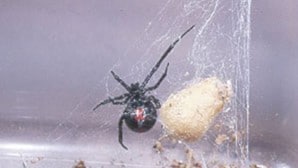Key points
- Outdoor workers may encounter venomous spiders.
- Black widows and brown recluses are some types of venomous spiders in the United States.
- Employers and workers can take steps to prevent spider bites.

Overview
Venomous spiders found in the United States include the black widow and the brown recluse. These spiders can be dangerous to outdoor workers. Spiders are usually not aggressive, and most bites occur because a spider is trapped or touched.
Types
Black widow spiders
- Have a pattern of red coloration on the underside of their abdomen.
- Build webs between objects.
- Bites may occur when contact is made with their webs.
- Bites may occur when contact is made with their webs.
- Bites have two puncture marks.
- The venom is a neurotoxin that produces pain at the bite area and then spreads to the chest, abdomen, or the entire body.
- Found:
- Throughout North America, but are most common in the southern and western United States.
- In workplaces containing undisturbed areas such as woodpiles, eaves, fences, and areas where debris has accumulated.
- Living in outdoor toilets where there are lots of flies.
- Throughout North America, but are most common in the southern and western United States.
Brown recluse spiders
- Also known as the violin spider.
- Brown with a dark violin-shaped marking on its head.
- Has six equal-sized eyes (most spiders have eight eyes).
- Cannot bite humans without counterpressure, like if it is accidentally trapped against the skin.
- Bites may cause a stinging sensation with localized pain. A small white blister usually develops at the site of the bite.
- The venom can cause a severe lesion by destroying skin tissue (skin necrosis). This skin lesion will require professional medical attention.
- Found:
- In the midwestern and southern United States.
- In workplaces with secluded, dry, sheltered areas such as under structures or logs or in piles of rocks or leaves.
- Indoors in dark closets, shoes, or attics.
- In the midwestern and southern United States.
Symptoms
Symptoms associated with spider bites can vary from minor to severe. Although extremely rare, death can occur in the most severe cases.
Possible symptoms resulting from a spider bite include:
- Itching or rash
- Pain radiating from the bite, muscle pain, or muscle cramping
- Reddish to purplish color or blister
- Sweating, fever, or chills
- Difficulty breathing
- Headache
- Nausea and vomiting
- Anxiety or restlessness
- High blood pressure
Prevention
Employers can protect their workers from spider bites by training them on:
- Their risk of exposure to spiders.
- How to identify spiders.
- How to prevent exposure to spiders.
- What they should do if they are bitten by a spider.
Workers can take the following preventive steps:
- Inspect or shake out any clothing, shoes, towels, or equipment before use.
- Wear protective clothing such as a long-sleeved shirt and long pants, hat, gloves, and boots when handling stacked or undisturbed piles of materials.
- Minimize the empty spaces between stacked materials.
- Remove and reduce debris and rubble from around the outdoor work areas.
- Trim or eliminate tall grasses from around outdoor work areas.
- Store apparel and outdoor equipment in tightly closed plastic bags.
- Keep tetanus boosters up-to-date (every 10 years). Spider bites can become infected with tetanus spores.
First Aid
If a worker is bitten by a spider:
- Stay calm.
- Identify the type of spider if it is possible to do so safely to aid in medical treatment.
- Wash the bite area with soap and water.
- Apply a cloth dampened with cold water or filled with ice to the bite area to reduce swelling.
- Elevate bite area if possible.
- Do not attempt to remove venom.
Immediately notify a supervisor and seek professional medical attention.
Resources
The Occupational Safety and Health Administration (OSHA) fact sheets provide information on spider identification, habitat, and bite symptoms. They also include bite treatment and worker protection.
The National Library of Medicine (NLM) resources provide descriptions of bite symptoms and hospital treatment information.
University of California: Brown Recluse (and Other Recluse) Spiders
Identification of brown recluses, descriptions of spiders commonly confused with brown recluses, medical misdiagnoses, and pest control.
